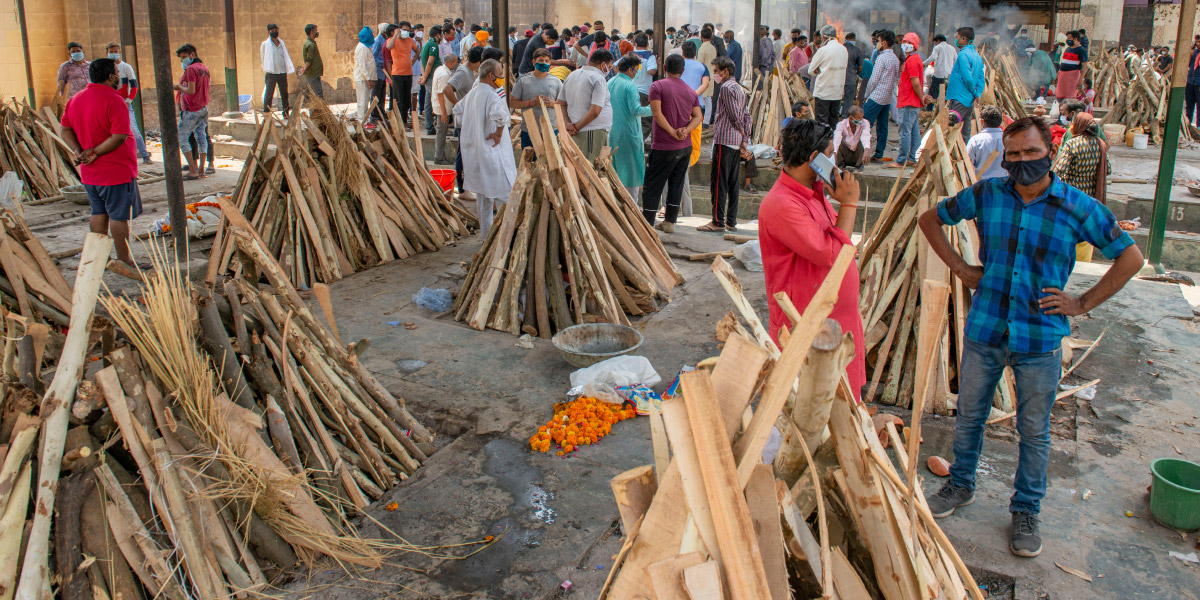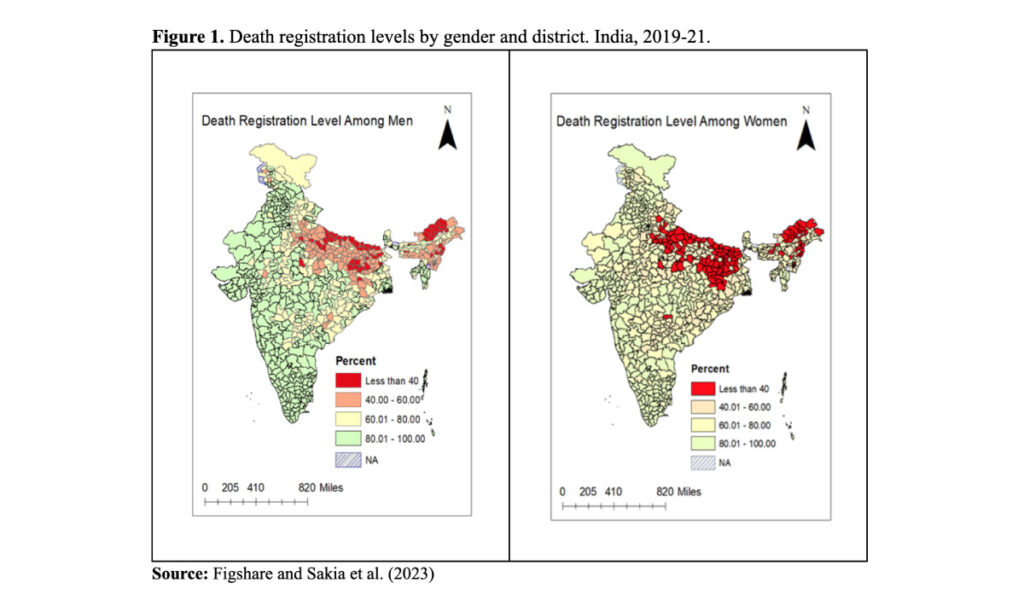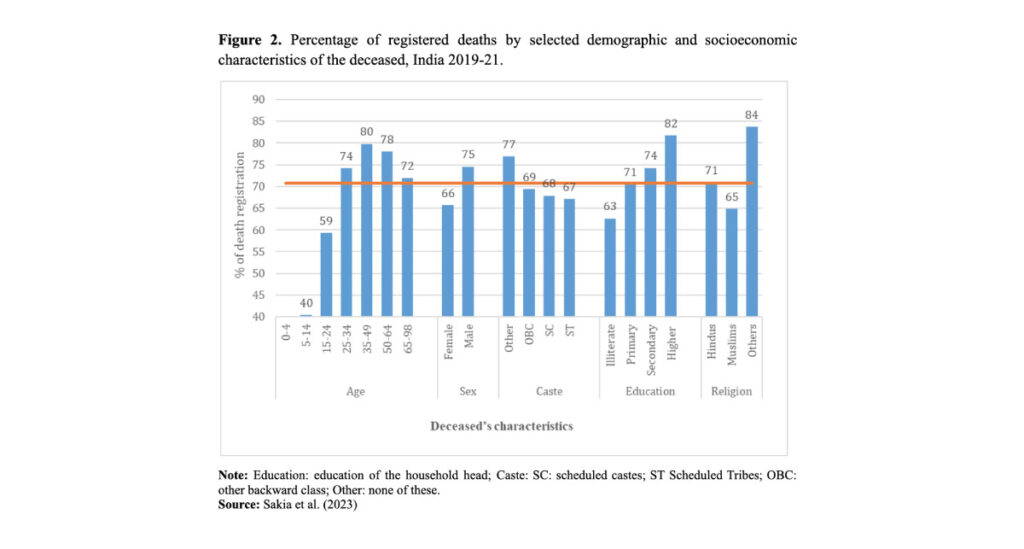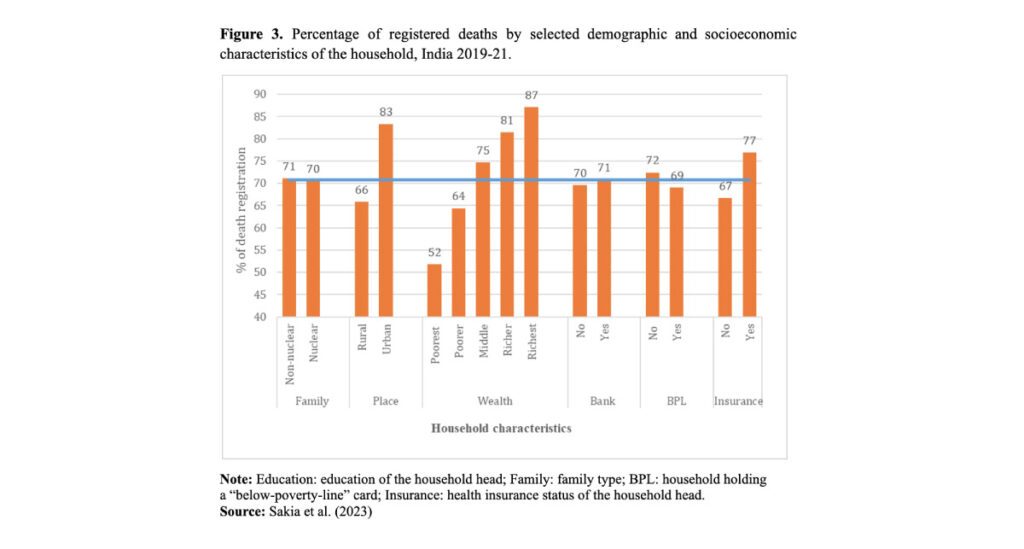April 17, 2023 Krishna Kumar and Nandita Saikia


The outbreak of the Covid-19 pandemic highlighted the importance of accurately counting deaths, classifying them by age, sex, place of residence and cause. Although formally mandatory since 1969, death registration is still deficient in India, especially among certain groups, as Krishna Kumar and Nandita Saikia illustrate.
Introduction
The Covid-19 pandemic has once again highlighted the importance of accurately counting deaths, and of classifying them by age, sex, place of residence and cause, so that health officials and decision-makers can identify health threats and high-risk populations (Sakia et al., 2023; Sankoh et al., 2020).
India, the second most populated country of the world, enacted its Registration of Birth and Death (RBD) act in 1969, mandating universal registration within 21 days of a birth or death. Today, however, things are still far from perfect. For instance, in 2020, there were around 5.6 million and 4.6 million deaths, respectively, among Indian males and females according to United Nations estimates (United Nations, 2022), but the Office of Registrar General of India (2022) “missed” some 6% of female deaths in that year.
This calls for an understanding of the determinants of death registration in India. This is the topic of our recent study (Saikia et al., 2023) based on 84,390 individuals interviewed during the National Family Health Survey, 2019-21 (NFHS-5) (IIPS & ICF, 2021). Note, however, that we relied on interviewees’ reports of family deaths and their registration in the previous year, without checking death certificates: errors of various types are therefore possible. Besides, part of the data collection took place in the post-Covid period. Due to the government compensation scheme for Covid-related deaths, higher-than-normal death registration is likely to have occurred.
Death registration level varies by place of residence, region, state and district
Between 2019 and 2021, according to our sample data, slightly less than 71% of deaths were registered, on average, with higher rates in urban than in rural areas (83% vs 66%, respectively). In the latter, most adults are employed in informal sectors such as farming, construction work and fishing, which seldom provide social security (e.g. survivor’s pension). Low registration levels may reflect a lack of motivation, few incentives and poor access to death registration services.
Death registration coverage varies geographically, and is particularly low in the Northeast (64%), East (57%), and Central (56%) Indian regions (Figure 1).

Death registration level vary by demographic and socioeconomic characteristics
Registration levels are higher for deaths at older ages, e.g. about 78% at 50-64 years, and 72% at 65-98 years (Figures 2 and 3). Conversely, they are very low for children: merely 35% at 0-4 years. Sex differences are large: around 74% of male deaths are registered versus 66% of female deaths. This difference is linked, among other things, to two factors:
1) a lower proportion of women employed in the formal sector (see above) and2) a higher proportion of accidental deaths among males. These are usually subject to police investigation, which increases the likelihood of registration (Adair et al., 2021).
Death registration was lower:
1) among the low-educated: 63% and 71% when the household head was, respectively, illiterate or had just primary education,
2) among Muslims (65%) than Hindus (71%),
3) among scheduled castes (or STs: 67%) than other castes (77%),
4) among poorer households (52% in the first income quintile; 87% in the fifth).


Conclusion
Death registration levels vary considerably by sex, age, place of residence and regions in India, and are influenced by socioeconomic variables. Periodic awareness programs may therefore be needed among vulnerable subgroups and in disadvantaged districts. Providing financial assistance for funeral rites, education loans to orphans, and social security to the deceased’s family members after reporting a death to a civil authority would probably prove helpful in increasing death registration coverage.
References
- Adair T, Gamage USH, Mikkelsen L, Joshi R. 2021. Are there sex differences in completeness of death registration and quality of cause of death statistics? Results from a global analysis. BMJ Glob Health. 6(10):e006660. doi:10.1136/bmjgh-2021-006660
- International Institute for Population Sciences (IIPS) and ICF 2021. National Family Health Survey (NFHS-5), 2019-21. IIPS: Mumbai, India.
- Niti Aayog – SDG India Index. 2021.; 2021.
- Saikia N, Kumar K, Das B. 2023. Death registration coverage 2019–2021, India. Bulletin of the World Health Organization. Feb 1; 101(2):102-10. doi: http://dx.doi.org/10.2471/BLT.22.288889
- Sankoh O, Dickson KE, Faniran S, et al. 2020. Births and deaths must be registered in Africa. Lancet Glob Health. 8(1):e33-e34. doi:10.1016/S2214-109X(19)30442-5.
- Setel PW, Macfarlane SB, Szreter S, et al. 2007. A scandal of invisibility: making everyone count by counting everyone. The Lancet. 370(9598):1569-1577. doi:10.1016/S0140-6736(07)61307-5
- United Nations. Department of Economic and Social Affairs, Population Division 2022. World Population Prospect. 2022.
Source fugure 1: https://figshare.com/articles/figure/Death_Registration_Level_by_Sex/21724049
No comments:
Post a Comment